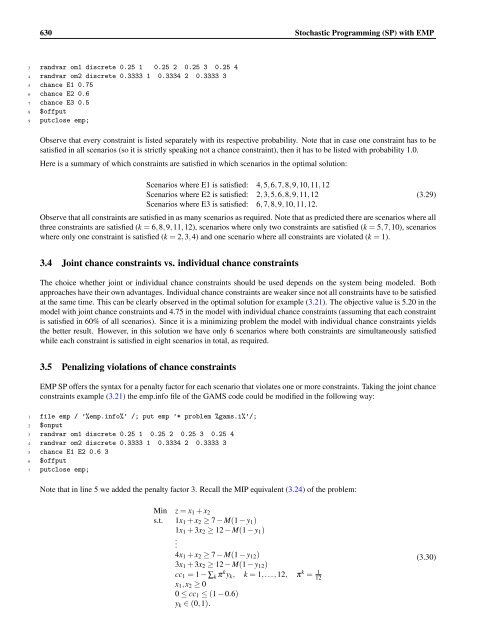Stochastic Programming (SP) with EMP - Gams
Stochastic Programming (SP) with EMP - Gams
Stochastic Programming (SP) with EMP - Gams
Create successful ePaper yourself
Turn your PDF publications into a flip-book with our unique Google optimized e-Paper software.
630 <strong>Stochastic</strong> <strong>Programming</strong> (<strong>SP</strong>) <strong>with</strong> <strong>EMP</strong><br />
3 randvar om1 discrete 0.25 1 0.25 2 0.25 3 0.25 4<br />
4 randvar om2 discrete 0.3333 1 0.3334 2 0.3333 3<br />
5 chance E1 0.75<br />
6 chance E2 0.6<br />
7 chance E3 0.5<br />
8 $offput<br />
9 putclose emp;<br />
Observe that every constraint is listed separately <strong>with</strong> its respective probability. Note that in case one constraint has to be<br />
satisfied in all scenarios (so it is strictly speaking not a chance constraint), then it has to be listed <strong>with</strong> probability 1.0.<br />
Here is a summary of which constraints are satisfied in which scenarios in the optimal solution:<br />
Scenarios where E1 is satisfied: 4,5,6,7,8,9,10,11,12<br />
Scenarios where E2 is satisfied: 2,3,5,6,8,9,11,12<br />
Scenarios where E3 is satisfied: 6,7,8,9,10,11,12.<br />
Observe that all constraints are satisfied in as many scenarios as required. Note that as predicted there are scenarios where all<br />
three constraints are satisfied (k = 6,8,9,11,12), scenarios where only two constraints are satisfied (k = 5,7,10), scenarios<br />
where only one constraint is satisfied (k = 2,3,4) and one scenario where all constraints are violated (k = 1).<br />
3.4 Joint chance constraints vs. individual chance constraints<br />
The choice whether joint or individual chance constraints should be used depends on the system being modeled. Both<br />
approaches have their own advantages. Individual chance constraints are weaker since not all constraints have to be satisfied<br />
at the same time. This can be clearly observed in the optimal solution for example (3.21). The objective value is 5.20 in the<br />
model <strong>with</strong> joint chance constraints and 4.75 in the model <strong>with</strong> individual chance constraints (assuming that each constraint<br />
is satisfied in 60% of all scenarios). Since it is a minimizing problem the model <strong>with</strong> individual chance constraints yields<br />
the better result. However, in this solution we have only 6 scenarios where both constraints are simultaneously satisfied<br />
while each constraint is satisfied in eight scenarios in total, as required.<br />
3.5 Penalizing violations of chance constraints<br />
<strong>EMP</strong> <strong>SP</strong> offers the syntax for a penalty factor for each scenario that violates one or more constraints. Taking the joint chance<br />
constraints example (3.21) the emp.info file of the GAMS code could be modified in the following way:<br />
1 file emp / ’%emp.info%’ /; put emp ’* problem %gams.i%’/;<br />
2 $onput<br />
3 randvar om1 discrete 0.25 1 0.25 2 0.25 3 0.25 4<br />
4 randvar om2 discrete 0.3333 1 0.3334 2 0.3333 3<br />
5 chance E1 E2 0.6 3<br />
6 $offput<br />
7 putclose emp;<br />
Note that in line 5 we added the penalty factor 3. Recall the MIP equivalent (3.24) of the problem:<br />
Min z = x1 + x2<br />
s.t. 1x1 + x2 ≥ 7 − M(1 − y1)<br />
1x1 + 3x2 ≥ 12 − M(1 − y1)<br />
.<br />
4x1 + x2 ≥ 7 − M(1 − y12)<br />
3x1 + 3x2 ≥ 12 − M(1 − y12)<br />
cc1 = 1 − ∑k π k yk, k = 1,...,12, π k = 1<br />
12<br />
x1,x2 ≥ 0<br />
0 ≤ cc1 ≤ (1 − 0.6)<br />
yk ∈ (0,1).<br />
(3.29)<br />
(3.30)

















